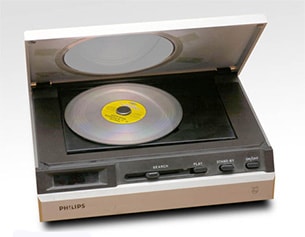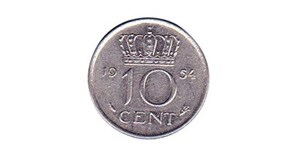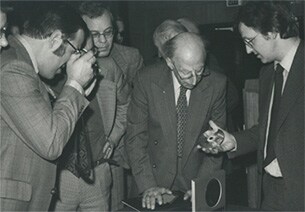While experimenting with equipment to record morse signals automatically, the 30-year-old Thomas Alva Edison accidentally discovered in 1877 that he had recorded sounds that resembled a human voice. Edison continued with his experiments and made a sketch of a ‘recording apparatus’ that was built by his instrument maker John Kruesi and was called a 'phonograph' by Edison.
The phonograph used a manually rotated cylinder coated with tin foil in which the pattern of the sound waves was engraved by a needle. When Edison tried it out for the first time, he turned the handle and pronounced in a clear voice the children’s song 'Mary had a little lamb...’ After the recording, he enthusiastically observed that how voice as clearly reproduced. The human voice had been ‘preserved’ for the first time ever. Emil Berliner Although Edison is often referred to as the inventor of the gramophone record, this honor is really due to Emil Berliner, who had emigrated from Germany and was the first person in the world to introduce such a device in 1888. By numerous experiments, he came to the conclusion that sound waves could better be recorded on flat discs than on the cylinders of Edison’s phonograph. Because in contrast to Edison, whose phonograph was intended for recording and reproduction, Berliner saw the gramophone and its records primarily as instruments that would allow everyone to listen to music by famous artists. In addition, Berliner thought that flat records or discs would be much easier to replicate than the phonograph’s cylinders. Berliner’s first record had a diameter of 12.5 cm, only half a centimeter larger than the Compact Disc that was to be introduced 95 years later. But Berliner’s disc had a playing time of barely one minute, while today’s CDs can contain around 80 minutes of music. After first using ebonite, Berliner soon switched over to shellac as the material for his records, and this continued to be used for the production of 78 r.p.m. records until the introduction of the LP (Long Play record) in 1948. Customers who purchased one of Berliner’s first record players were able to enjoy recordings of popular numbers such as 'Twinkle, Twinkle, Little Star' and 'Our Father', which they received free with their players. Electrical recordings The electrical recordings, which became possible from 1927 onwards, represented a major improvement in every respect. Not only was the frequency range greatly increased, but things also became a lot easier for the recording technicians and artists thanks to the introduction of the microphone and the disappearance of the huge 'funnels' from the recording studios. But Edison again was not impressed. He continued to prefer mechanical recording even for his Long Play record as a result of which he gradually faded out of the picture in the music industry. That may well have saved him a lot of money, because at the beginning of the 1930s record sales collapsed; from more than 100 million copies in 1927 to barely 6 million in 1932.
But even though Edison greatly improved his phonograph in the following years, it was destined to have only a relatively short lifetime. Because ten years after its invention the gramophone record was developed.
However Edison never believed in Berliner’s flat records, and stubbornly continued with his cylinders. After many improvements his cylinders gave much better sound reproduction than Berliner’s records, leading to battle between the two systems that was finally won by the record. Finally Edison also developed a gramophone record, even introducing a 30 cm Long Play record with a playing time of around 20 minutes. But despite its excellent sound quality this record was not a success, the public instead choosing the 78 r.p.m. shellac records with horizontal (lateral) recording, while Edison remained faithful to the same vertical (‘hill-and-dale’) recording principle that had been used for his cylinders.
It would take until after the Second World War before the LP became commercially available, even though it had been developed as long ago as the early 1930s by RCA. The shellac record continued to exist for some time next to the unbreakable LP, but it disappeared as soon as the 45 r.p.m. record was introduced.
The mono Long Play record of the 1950s and 60s had an extremely good sound quality, which was due partly to the advanced state that recording techniques had by then reached, as well as the constant improvements in the gramophones, which by then were called record players or turntables. The stereo record was introduced in the mid-1960s. At first this was a disappointment, because the sound quality was noticeably poorer that that of comparable mono records. However the record industry was able to improve the quality of stereo records significantly within a few years, and even introduced 'quadraphonic' (4 channel stereo) discs at the beginning of the 1970s. But quadraphonic sound was not successful. Not only were the techniques used at the limits of what was achievable at the time, but also the biggest problem was that in a short time four different and incompatible quadraphonic systems came onto the market at the same time! This meant that music enthusiasts had to buy four different decoders plus a new pick-up element with a specially shaped diamond needle to allow them to listen to the different quadraphonic records!

Prototype of CD player

Did you know? The inner hole of a Compact Disc (CD) matches the size of an old-time Dutch coin.
The digital era Shortly after the demise of quadraphonic sound, the electronics industry moved into the digital era, and particularly optical recording. Following the pioneering work of Philips on an optical video player in the early 70's, a project was started in 1974 within Philips and its Research laboratories to develop a digital optical audio disk with error correction code. Parallel work on digital optical audio recording was done in a number of companies and Sony first publicly demonstrated an optical digital audio disc at the 1977 Audio Fair. On 8 March 1979, Philips demonstrated for the international press a 11.5 cm Optical Disk and a Compact Disc Audio Player. The demonstration showed that it is possible by using digital optical recording and playback to reproduce audio signals with superb stereo quality. Through the co-operation with Sony the final diameter was 12 cm and the initially proposed resolution (accuracy) of 14 bits was increased to 16 bits. With this concept Philips and Sony took the first step in setting a worldwide standard.
For this breakthrough innovation, Philips received the IEEE milestone award in 2009.
In January of 2015, the CD was awarded as the most valued Philips innovation, voted by readers of the Eindhovens Dagblad and listeners of Omroep Brabant, as well as by Philips Research employees. Both the public and the Research employees were unanimous in voting for the CD as the winner.
Want to learn more about the history of the CD? Read the article ‘The emergence of the compact disk’ by Hans B. Peek here.
More information on the CD

The press sees the Compact Disc for the first time
